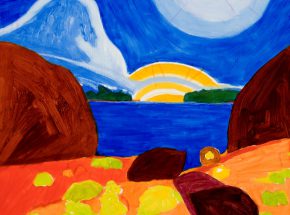

In conversations about my painting, I regularly volunteer that I am a frustrated architect, and viewers of my work rarely disagree. American architecture, in particular, has called to me–for its exquisite simplicity, made all the more becoming by the handsome details applied to “dress it up.” Moldings, turrets, weather vanes, cupolas, widows walks, gables, porches, trellises not to mention the wonderful clash of materials that accompany them–slate, cedar, stone, clapboards, tin, brick, copper, stained glass–offer interesting combinations that when handled in the light of different times of day are endless in their richness and variety. Because many of the best architectural specimens in Rhode Island and New England occupy marvelously landscaped settings on the coast, I have also paid attention to organic materials, the sea, and the sky. These places, the man-made objects and the natural settings they inhabit have taught me to see. With this enhanced awareness, special scenes -trucks full of pumpkins, frost on windows, tires in the snow-have revealed themselves and summoned me to look even closer for exceptional images to capture.
As a watercolor painter with no formal artistic training, the exploration of art history has had a tremendous influence on my work, encouraging me to place more emphasis on imagery than polemics. Argument in painting, in fact, has always seemed to me to be unnecessary. Beautiful colors and shapes can be brought together to create angst, tension or even dyspepsia, but when the same colors and shapes are used to create a more positive or thoughtful experience, my reaction is why not? Getting my paintings to shout hatred, racism or mean-spiritedness might be a more accurate reflection of the world today. I have chosen instead, perhaps like those who decorated their caves at Lascaux, to put adornment first. We all yearn to spend more time in the grip of the sublime. That my work might nudge a viewer in this direction is my modest hope.
My paintings then are meant to be pleasing to look at, and at the same time intellectually stimulating. For some, they are what they are-a window, a roofline, a door ajar. For others, owing to a large degree to my use of close perspective, they are thoughtful abstractions of lines and surfaces caught in the push and pull between what’s near and what’s far away. I elevate the simplicity of the subject, but invite my viewers to reach their own conclusions.
